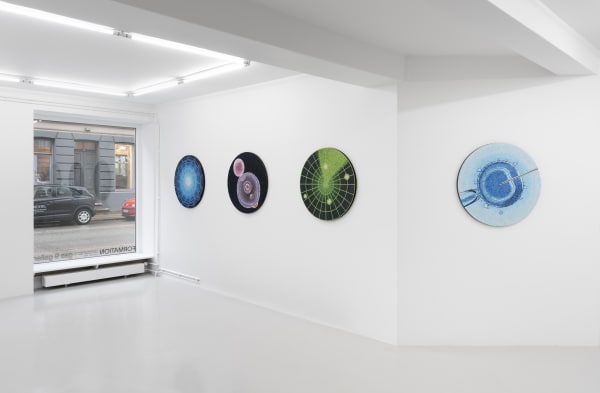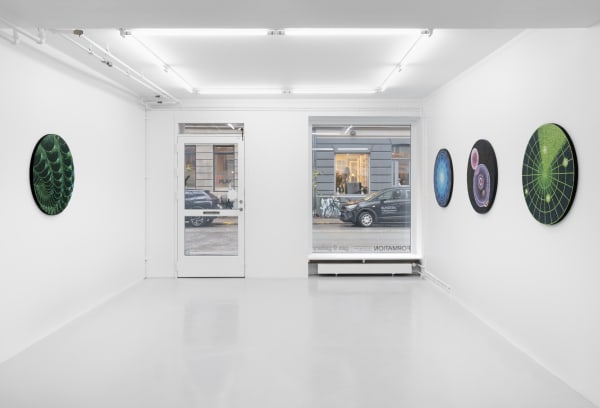Jens Settergren: Bubbles, Orbs, Oracles
The gallery present the exhibition Bubbles, Orbs, Oracles by Jens Settergren, that engages with questions that we all too rarely ask ourselves: Where do images come from, what do they represent, and how do they affect us? He presents new lenticular prints and mosaic works where motifs from bio- and computer technology become enchanted when produced in thousands of tesserae rendering their surface like pixels in modern digital imagery. With aesthetics that span ancient image technologies, science-fiction visions, contemporary advertising language and imagey from the natural sciences, Settergren delves into the logic of imagery, perhaps rendering the works as a kind of fuel for our unconscious, collective, aesthetic memory.
Exhibition text by Kristian Vistrup Madsen
Carving Rorschachs in the sand and watching as a gentle tide washes them away - this is a scene from the edge of history; a scene about the end of what, for a while, we have understood as linear time and its effect on image production. I picked the image out of Jens Settergren's lenticular print where words shimmer in and out of view like responses to a Rorschach test and with the solemn transience of lines in the sand.
The inkblots developed by the Swiss psychologist Hermann Rorschach in the 1920s as windows into the unconscious are, perhaps, the images most emblematic of that century. Abstraction is often understood to have developed as a visual language in modernism in order to describe an increasingly alienated relation to what it means to be human. But abstract images like Rorschach's ten inkblots are also about perception and its relationship to subjectivity; not what we experience but how that experience produces selfhood. These carefully ambiguous designs point to what has always been the topic of art - the unknown and inexplicable; the nature of life and death - but in the language of the 20th century's new religion: science, objectivity, rationality. Settergren's work is an ambivalent, if not melancholy reflection of this mindset: To carve Rorschachs in the sand requires a deliberation entirely contrary to the logic of the test, just as his invocation of the 'gentle tide' that will wash the pictures away suggests a kind of resignation; a lack of faith in the unconscious as a source of truth; or, worse, to have ceased to believe that whatever knowledge accessed by the inkblots will make any difference at all.
Though modernism derived a lot of energy from the idea of producing newness in art, abstraction, of course, is no modernist invention. The cathedral of Monreale in Sicily is covered in golden mosaics from the 12th century that illustrate the Bible from start to finish. The panel that describes the first stages of genesis - God separating light from dark, and land from sea, the invention of the horizon - is, naturally, an assemblage of geometric forms, lines and fields of colour. What was new, then, was not the visual language itself, but the idea that abstraction should be anything other than a source of mystery; that the unconscious could be mapped, and the mysteries of creation and selfhood uncovered once and for all. Modernity seemed to work towards a concept of the unknown that was not, as in the Baroque, for instance, tragic and intense, but triumphantly mundane. The doctor who conducts a Rorschach test is obliged to write down any and all associations of the patient, no matter how trivial. In psychoanalysis, the point is to go on talking for so long that speech becomes babble; a kind of regression into banality.This is a project of disenchantment; of revelation not as divination but abdication of mystery. Science, then - to which Freud so aspired with his clinical studies - means knowing what abstract pictures are of: the stars as seen through a telescope, cells through a microscope, the brain through an MRI scan.
Settergren's lineup of pictures - details of what appears to be scales, a radar, or microscopy, all assembled in glass mosaics - exist in this strange overlap between past and future, abstraction and some sort of indexicality. The LCD font used in the lenticular print poem already belongs to a late twentieth century childhood, just as the mosaics belong to Monreale or even to Pompeii. In his game with the retro-future, Settergren enlists the affects that attach to certain media or formats in order to reinstall a sense of mystery, or point to the ways in which it was always there. We could say that mystery in Settergren's work - and perhaps today, more generally - is supported by the scaffold of how we remember, not the things themselves, but the style of their mediation. Perhaps these appeals to our collective aesthetic memory are like the designs Rorschach contrived to trigger our unconscious, except where science and modernism disenchanted the abstract image, Settergren imbues it once again with a mythical force. Because, of course, we believe in the power of these disenchanted images as we used to believe in God.
And this is where we find Settergren's work, on the beach with the Rorschachs disappearing in the sand: suspended between a clarity we might just be better off without and the helplessly human fixation on existence as enigma. An earlier lenticular print shows a rendering of a fetus, which, as you pass, reveals the green, digital scaffold behind the appearance of skin. The image of the baby is at the centre of European art history as an illustration of the mystery not just of birth, but the very first birth: the immaculate conception. Settergren's perfect glossy image recalls the slickness of advertisement and the secular authority of science; life made to measure, total control. But just as psychoanalysis contains the impulse to map and to steer as well as an attraction to metaphor and mysticism, we might also see in this picture the recalcitrance of what will not be explained; in the 'miracles' of science and technology merely a new frontier for the same old unknown. From the luminous whites that flare up across his mosaics we might glean that the most destructive power on Earth is not volcanoes or earthquakes but our own dreadful and magnificent talent for survival.
Kristian Vistrup Madsen (DK) is a writer, art critic and curator based in Berlin. He writes texts about art, music and architecture for exhibition catalogs, art anthologies and journals, e.g. Artforum, Frieze, Mousse, The White Review, Texte zur Kunst and Kunstkritikk.






